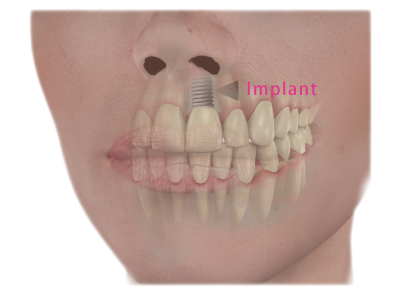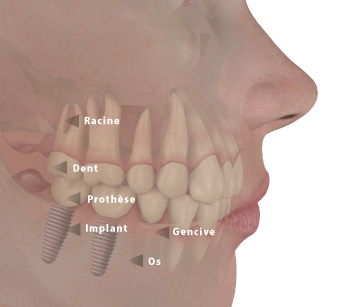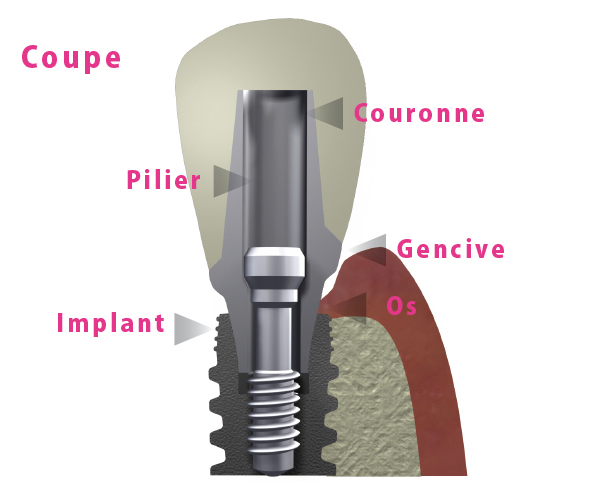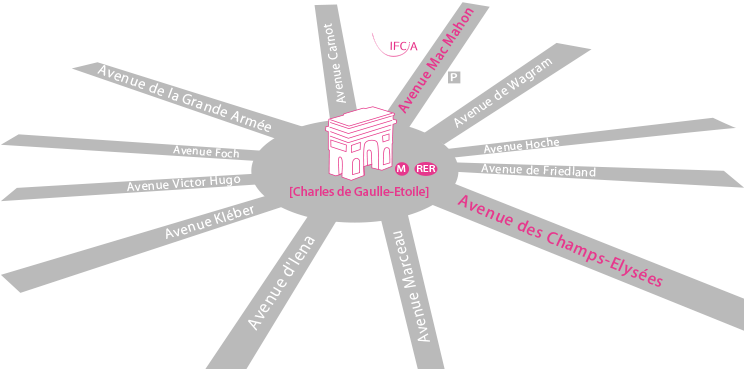Dental Implants
Last Update: 16 April 2013 | Learn all
What is the definition of a dental implant?
An implant is an artificial root inserted into the bone of the jaw and intended to create a resistant and long-lasting rooting on which the dental surgeon adapts in a second phase a prothetic element (one or several false teeth).
History
It is only at the beginning of 1980s when significant progresses were carried out in the field of the oral implantology. A Swedish surgeon, Pr. Bränemark and his team published several studies concerning total teethless patients treated by means of implant prostheses (bridges on implants). The period of observation is of 15 years. The titanium is used for the manufacturing of implants and a time limit from four to six months is fixed between the implant placement and the one of the prosthesis. The results are excellent, very superior to those obtained with the other already current techniques oral implantology. The interest for this discipline is then boosted. New scientific newspapers are created, new researches are published, training centers for the dental surgeons appear all over the world.
Evolution or Improvements
It does not matter whether the Titanium used is pure or weakly alloyed the mechanical properties of materials used for implants were improved. The area of connection between the implant and the prosthesis, very much actioned by the chewing and sometimes the weak point of the implant recovery, is more resistant and more reliable time wise today. New diameters of implants (wide implants) also appeared to treat situations where the mechanical constraints are important (replacement of molars, for example).
Other improvements: the time necessary for the bone reconstruction around the implant tends to grow shorter thanks to the new implants which, textured and rougher surface, allows a faster colonization of the osseous cells. In certain cases, a temporary fixed prosthesis can be realized the day of the implants placement or a little later. It is what we call the immediate loading. The results are excellent if the indications are well fixed. On the other hand, the geometry of implants evolves: besides the permanent availability of cylindrical implants, conical forms are used nowadays. These allow to obtain a better primary stability of the implant and to handle successfully the situations where the bone is little dense; this was not always possible with the cylindrical implants.
Finally, other evolution: bone grafts. It is now possible to take, under local anesthetic, a few bones from the lower jaw to transplant it where it is missing, mostly in the upper jaw. This technique allows the treatment of patients with reduced jaws or presenting aftereffects of accidents. When the osseous reconstruction preceding the implants placement requires the use of more voluminous transplants, the bone harvesting can then be made in the thickness of the cranial bone or at the level of the iliac crest . This intervention is then realized under complete anesthesia and requires a short hospitalization. New progresses concern biomaterials imitating the bone structure ; they are often used to avoid the recourse to an osseous taking. They are called ostéoconductors, sometimes ostéoinductors and act like a scaffold in which the bone cells can progress, settle down and produce new bone tissue. Bone autografts and biomaterials must not be set. They have their proper indications..
Implant placement
It is realized almost always under local anesthetic. The surgeon cuts the gum and, by means of a bit, realizes a small opening in the bone of the jaw. The implant – which is generally a titanium srew – is then set up. Operating consequences are mostly insignificant. Between the implant placement and that of the prosthesis, it is necessary to wait between six weeks and six months so that the implant becomes integrated perfectly into the bone of the jaw this phenomenon is called osteointegration. The bone tissue cell colonize the surface of the implant, forming a sort of a stiff callus. It is the same phenomenon which occurs during the healing of an arm or leg fracture. In certain cases, implants and prosthesis can be realized in the same day. This corresponds to well precise indications and requires a close collaboration between the surgeon and the family doctor.
Les avantages des implants
The implantary treatment allows:
- To avoid the recourse to a removable prosthesis (dentures) or to eliminate an already existing and badly tolerated removable prosthesis. Thanks to implants, a fixed prosthesis is then realized and the patient benefits from a better comfort, from a better chewing efficiency, often from a better speech and from a better image of himself.
-
Not to crown teeth next to the toothless area (like it is necessary to do when a traditional bridge is realized). This is obviously very interesting if these teeth are healthy, and also in situations where these neighboring teeth are treated but remain fragile and unfit to support a bridge (short roots, dental mobility).
- To stabilize a removable prosthesis which would be unstable and ineffective. Implants receive then systems of attachment which allow to stabilize firmly the prosthesis during the chewing and the phonation. The patient continues however to remove his prosthesis for the daily hygiene care.
In certain cases, the implant treatment is not indicated (quality and insufficient quantity of bone, for example) and it is up to the dental surgeon to advise at best his patient.
Dans certains cas, le traitement implantaire n’est pas indiqué (qualité et quantité d’os insuffisante, par exemple) et c’est au chirurgien-dentiste de conseiller au mieux son patient.
The failures(chess)
The failure rate is low: from 2 % to 5 % ( Ref. LE FIL DENTAIRE N°12 Avril 2006 DAVARPANAH M. et Coll). The age of the patient, when the latter is healthy and when the bone of the jaw is satisfactory in quantity and quality, does not appear as a factor risk today.
Implant Shelf life
We have in France about twenty years of hindsight. The Swedish surgeons having begun to treat patients in the middle of the 60s, have now about forty years of hind sight . So, even if it is taken for granted that most of the implants are placed for a minimum period of ten years, their shelf life is often superior in fact. On condition however that the patient has a good dental hygiene and has his implants checked every year.
Some figures
110 000 implants were placed in France in 2002, according to a study of the Millennium Research Group (Toronto, Canada) (“Eastern European Markets for Dental Implants 2008) “. The technique is rapidly expanding (+ 22 % in France in 2002). Nevertheless France is late in comparison with Germany, Italy or even Spain. In these countries, the number of implants placed in 2002 was respectively 419 000, 409 000 and 168 000.




